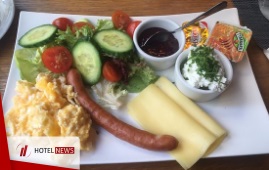
In Poland, where breakfast is known as śniadanie , you might dine on an open-face sandwich, or zapiekanka or kanapka (popular word for “sandwich”), made of cold cuts, meat spreads, kiełbasa, cheese, tomatoes and sliced pickles. Hot dogs (without rolls) are popular as well. Bread and rolls of all types figure prominently at the Polish breakfast table. Bread is usually fresh, warm and crispy
Create: May 15, 2019 Edit: May 16, 2019 Cookies
Fresh bread is ready every day. There are different kinds of flatbread, which is popular for breakfast in Iran: noon-e barbari, a long, oval shaped bread with doughy ends; noon-e sangak, wheat flatbread baked on rocks; and noon-e taftoon, a round, white flatbread. One cannot ignore the delicious savior of feta cheese and walnut with sangak bread or the great taste of fruit jam or honey with butter on barbari bread. Sometimes sliced cucumber and tomato are also served during an Iranian breakfast as well. Tea is the most important drink amongst Iranian. They drink tea all through the day but they serve tea with sugar during breakfast time.
Create: May 15, 2019 Edit: May 16, 2019 Cookies
Don't rush your guests! One of the thing that we really don't like is to rush the gusts. Follow the situation and at what stage the tables are. If you see empty plate don't just assume that the person finished the meal. Observe. Give every guest 1-2 minutes after they stop chewing before you clear the table. We all know the restaurants are busy but never show that tou your guests. Keep calm at all time.
Create: May 15, 2019 Edit: May 16, 2019 Waiter
French Table Setting The French cover includes an hors d’oeuvre plate (or show plate), napkin, dinner fork, dinner knife, soup spoon, butter plate, butter spreader, dessert fork and spoon, and a water or wine glass. Advantages and Disadvantages of French Service The advantages of French service are that guests receive a great deal of attention, and the service is extremely elegant. The disadvantages are that fewer guests may be served, more space is necessary for service, many highly professional servers are required, and service is time-consuming.
Create: May 15, 2019 Edit: May 16, 2019 Waiter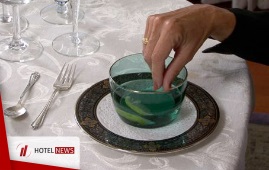
Finger bowls bowls of warm water with rose petals or lemon slices in them These bowls are served with all finger foods and at the end of the meal. The finger bowl is set on an underliner, a small plate with a doily, and placed, with a clean napkin, in front of the guests. Soiled dishes are cleared only when all guests have completed their meals.
Create: May 15, 2019 Edit: May 16, 2019 Waiter
Typical specialties that may be served in the French style are La Salade C´esar (Caesar salad), Le Tournedos au Poivre (pepper steak), and Les Crˆepes Suzettes (crˆepes in orange sauce). French service employs two servers working together to serve the meal and may include a captain to seat guests and a wine steward to serve wine. The principal server is the chef de rang (or experienced server), who seats the guests when a captain is not present, takes the order, serves the drinks, prepares some of the food with flourish at the guests’ table, and presents the check for payment. The assistant is the commis de rang, who takes the order from the chef de rang to the kitchen, picks up the food and carries it to the dining room, serves the plates as dished up by the chef de rang, clears the dishes, and stands ready to assist whenever necessary. All food is served and cleared from the right of the guests except for butter, bread, and salad, which should be placed to the left side of the guests.
Create: May 15, 2019 Edit: May 16, 2019 Waiter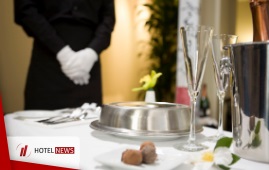
French service is a formal type of service originated for European nobility and currently enjoyed by the few who can afford the time and expense of meals served in this manner. This type of service is used in upscale restaurants, elegant hotel dining rooms, cruise ships, resorts, and casinos. In French service, the food is either cooked or completed at a side table in front of the guests. The food is brought from the kitchen to the dining room on heavy silver platters and placed on a cart called a gu´eridon. A small spirit stove called a r´echaud is used to keep the food warm. The food is completed by cooking, deboning, slicing, and garnishing as necessary and served to the guests on heated plates. Only those foods that can be cooked, assembled, or completed in a reasonably short time are prepared in front of the guests.
Create: May 15, 2019 Edit: May 16, 2019 Waiter
Traits of one style of restaurant overlap with traits of another, creating a unique identity. For our purposes here, we could say that types of establishments form somewhat of a continuum. On one end of the continuum would be restaurants with minimum service, no covers or simple placemats, a quick pace, fast foods prepared easily, and a general informality to the entire operation. The other end of the continuum would be the establishments with luxurious surroundings; table linens; silver serviceware; china; crystal glassware; flowers; soft music; an unhurried pace; skilled servers, and expensive, well-prepared, and well-presented foods and wines. Family-style restaurants, diners, and some chain restaurants would be on one end of the continuum; trattoria, bistros, and supper clubs in the middle; and classic gourmet, upscale, and fine-dining restaurants on the other. No matter which combination of amenities make up the whole, the guest has every right to expect a smile, that his or her order be correctly taken and delivered, and that the check is presented promptly and for the correct amount regardless of the setting. Good service is still the key to running any successful operation.
Create: May 15, 2019 Edit: May 16, 2019 Waiter
Many terms are used to describe types of restaurants, such as tearoom, family-style, upscale, casual, theme, and quick-service. The fact of the matter is that restaurants are subjectively classified by the style of operation. There are no clear characteristics for each type of establishment.
Create: May 15, 2019 Edit: May 16, 2019 Waiter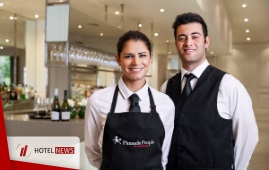
Give coworkers assistance when they need help and you are not busy. For example, help them carry trays of food when they are serving an especially large party. If a guest in a coworker’s station asks you for service, either cheerfully render the service or inform the guest’s server. As a member of the team, the coworker should return the favor when you are busy. Refrain from chatting or gossiping with coworkers in the dining room. Your responsibility lies with your guests when you are on duty. If you have spare time, use it productively to check your station, clean and fill condiment containers, fold napkins, and replenish the sidestand. If you are ill, notify your supervisor as soon as possible. Absenteeism without proper notification may mean that a coworker must assume double duty if a replacement is unobtainable. If even one member of your restaurant’s team falls short of his or her duties, it creates a ripple effect and puts pressure on everyone. The outcome affects the entire operation.
Create: May 15, 2019 Edit: May 16, 2019 Waiter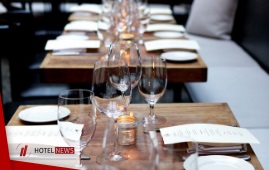
Teamwork means cooperating and working together with coworkers and the supervisor of the dining room to serve the public. A serving team is like a football team, working toward a common goal. Whether the goal is a touchdown or a satisfied guest, the principles are the same. Use the following guidelines to help foster teamwork: Arrive to work with a positive attitude. Leave your personal problems at home, and do not discuss them with coworkers or guests. Be cheerful and happy in your work; this attitude spreads to other workers and to the guests. Remember, guests come to the restaurant to relax and enjoy a special occasion in pleasant surroundings. If you have problems on the job, work them out or discuss them with your supervisor instead of with coworkers. Work can be pleasant or unpleasant, depending on your attitude toward it. Avoid raising your voice to any coworker or the chef when problems arise. Instead, try to handle the situation calmly. Some managers will train you in other jobs (chef, busser, and host) or allow you to experience other positions to build empathy with coworkers. Remember, you are a professional and a representative of the restaurant, and you should handle problems with coworkers in a professional manner.
Create: May 15, 2019 Edit: May 16, 2019 Waiter
The organization or arrangement of jobs in a restaurant diagrammed on paper is known as the organization chart. Knowing how you fit into the organization chart helps you function in your job. In the dining room organizational structure, bussers and servers report to their immediate supervisor, who may be a head server. The head server reports to the host or maˆıtre d’hˆotel, who reports to the dining roommanager. The dining room manager reports to management. In small restaurants, one person may assume several of these positions. For instance, your immediate supervisor may be a maˆıtre d’hˆotel or host who also assumes the head server’s job. In large restaurants, additional staff, such as an expeditor, may help the server bring food from the kitchen. To avoid causing problems within the organization, follow the organizational structure. When you have questions or problems concerning the rules, regulations, or policies, talk to your immediate supervisor. Your supervisor has more experience and is in a position to solve certain problems.
Create: May 15, 2019 Edit: May 16, 2019 Waiter
